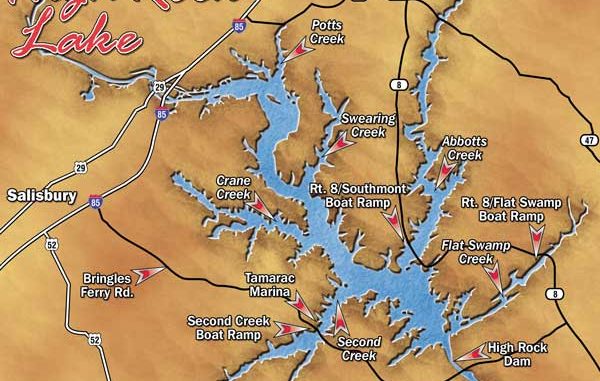
High Rock Lake has rebounded to become the Piedmont’s top crappie spot, especially for dock ‘shooters.’
After the exceptional drought of 2002 that dropped High Rock Lake more than 21 feet below full pool, many anglers pondered the fate of the lake’s once wonderful fishery.
While bass fishing boomed immediately after the drought, and the striped bass fishery slowly showed signs of improvement, crappie fishing throughout 2003 appeared to be in a funk. Mediocre weigh-ins at crappie tournaments and an abundance of half-dollar sized fish suggested that something was terribly wrong.
While High Rock never had produced truly jumbo crappie, it had become noted for its large numbers of 1-pound fish, with an occasional 2-pound slab in the mix.
Disgruntled fishermen theorized about what had happened. Some argued that the drawdown had forced all the fish together, and the smaller crappie had become easy prey for larger species. Others believed that crappie were swept through the dam with the drawdown or adversely affected by the change of habitat — or maybe fishing pressure was the culprit.
Lawrence Dorsey, a fisheries biologist for the N.C. Wildlife Resources Commission, waited for hard data from an impending fall crappie study before making a judgement, though he said turbid water and the cyclical nature of crappie populations could be factors.
During the spring of 2004, the fishery rebounded. At an April 3 tournament held by the Southern Crappie Association, the top five teams caught 10-fish limits weighing 10 pounds or better. Fishermen weighed in six crappie heavier than two pounds. Casual anglers also reported improved catches.
Dorsey’s 2003 crappie study brought more encouraging news. It found the black and white crappie populations were adequate and in good condition — despite the drought.
The data indicated “a growing and well-conditioned population.” No missing age classes appeared, and reproduction was constant across years.
Last year, crappie fishing at High Rock put to rest most fears as anglers experienced excellent results. And because the fish are back, old and new crappie tactics can help fishermen put even more slabs in the boat.
Randy Pope of Hickory and Greg Pruitt of Vale represent the old way of catching crappie. Winners of the SCA’s Classic three years in a row — including once on High Rock — the two fishermen use a technique that’s almost gone the way of the dinosaur.
Pope and Pruitt are “shootists,” but they aren’t armed with Old West lead slingers. Instead, their weapons are 4½- to 5-foot light- and medium-action crappie rods and Wally Marshall or Quantum PT spinning reels spooled with 2- to 4-pound test Stren Magnathin line tied to 1/32- or 1/64th-ounce jigs.
“We started shooting with spincast reels, but we wore the push buttons out by holding them down,” Pruitt said.
Although their weapons are ultralight, they’re as accurate and deadly as any six-shooter. With a bend of the rod, they can propel a tiny jig into 4-by-4-inch crevices and holes around docks.
“The harder the place to get the jig, the better we like it,” said Pruitt. “These fish aren’t pressured. Fishermen using long poles can’t reach them. They might catch crappie hanging at the edges of piers, but the better fish are at the far reaches of piers.”
Their shooting technique (also called “slingshot casting”) requires a short rod that bends almost to its tip as it’s held in one hand, while the jig is held carefully in the other hand and pulled to bend the rod. When the jig is released, the spring of the rod drives or skips the jig far beneath the dock. Care must be taken to hold the jig so you don’t drive the hook into the hand or finger upon release.
Shooting docks was a widely-used technique during the infancy of crappie tournaments. However, as power trolling with numerous rods gained popularity, shooting docks became almost a lost art among competitive anglers. Shootists can use only one rod at a time, while trollers can put out as many rods as tournament rules will allow.
Despite the advantages of trolling, Pope and Pruitt have more than held their own by outshooting the competition with their slingshot approach, which they said works year-round at any lake with piers and docks.
Besides use of the proper equipment, the most critical factor in shooting docks is knowing which docks to target.
“At first, we thought we had to fish docks and piers near deep water to be successful,” Pruitt said. “But some lakes, like High Rock, always have some color to them, so you can’t fish too shallow.”
Pruitt and Pope prefer floating docks over stationary docks for two reasons — floating docks cover a wider area of water and can hold more fish, and they feature only small areas that are difficult to fish.
“Stationary docks and piers are rookie places that anyone can fish, but floating ones are more difficult to fish and often bypassed by anglers,” Pruitt said.
“Most anglers give up before they fish the tight spots we cast to. It’s hard to fish the way we do. Shooting tight places requires bending and kneeling and boat positioning. It’s not like trolling where you can sit back, eat and have a drink.”
The best floating docks and piers at High Rock have six to eight feet of water in front of them. Pruitt and Pope also target pontoon boats because they cover wide areas of water and are difficult to fish.
The two anglers disagree with the notion that old, wooden piers are better than new ones.
“The type of wood doesn’t seem to matter,” Pruitt said. “Don’t shy away from new piers, especially main-channel piers, because they’re more adaptable to seasonal patterns.”
Pruitt and Pope caution anglers not to give up on seemingly unproductive piers.
“Crappies move in and out in waves, especially from March through May,” Pope said. “You can return to the same pier and catch fish where there were none previously.”
During a SCA Classic at High Rock, Pruitt said he and Pope fished a row of piers at 9 a.m. and caught two fish, then returned at 1:30 p.m. and caught 40 fish.
Pruitt and Pope said each pier or dock has a sweet spot where the majority of fish gather. They shoot these structures methodically to find those spots so they can focus on them on return trips.
“We shoot the front and outside corners of piers first to catch fish without spooking others and gradually move to the backs, keeping our distance with the trolling motor,” Pruitt said.
“If a pier pattern develops where fish are hitting mostly at the backs, that’s where we’ll fish. We give a pier a few minutes to produce before leaving it. We run a lot of piers.”
Pruitt and Pope sweeten piers at High Rock with brush, favoring hardwoods and holly trees over Christmas trees, which aren’t as effective. They rarely fish bridges unless they’re struggling.
And they rank High Rock as the best lake in North Carolina as far as numbers of fish.
“We love High Rock,” said Pope, who grew up fishing Lake Hickory. “It’s an old lake that you can fish shallow or deep for big fish.”
Capt. Jerry Neeley of Jerry’s Fishing Guide Service (www.carolinasfishing.com) and his assistant, Chris Nichols, also incorporate old and new crappie tactics into their arsenal, utilizing shooting docks, casting and slow, vertical trolling.
Neeley started fishing High Rock Lake 25 years ago and now averages about 50 trips a year to the lake, guiding mainly for crappie with Nichols’ help. Except when power trolling, Neeley and Nichols — like Pope and Pruitt — target High Rock’s docks and piers.
They also favor wider docks and piers, but are more insistent that they rest in eight to 10 feet of water.
“Docks with less than eight feet of water in front of them are not always productive,” Neeley said. “On sunny days, the shaded places at docks are best.”
Neeley and Nichols also prefer water with color to it, and given dingy water, Neeley fishes a jig with some white coloration because it’s more visible to fish.
They sample docks, fishing various depths with jigs of different colors until they locate the fish.
“Find the right depth, fish docks at that depth, and you’ll catch fish,” said Neeley, who often catches 100 crappie a day at High Rock. “It’s not that hard; it’s not rocket science. Crappies stack up under the piers.”
Neeley often casts to the same spot several times to trigger the crappie bite.
“Once you get the bite going, you can catch 10 to 50 from one pier,” he said.
Neeley and Nichols aren’t particular about the age of the pier, either.
“The type of pier matters at other lakes, but not at High Rock,” Nichols said. “The lake has so many crappie, the fish are just looking for places to get out of the sun. Any pier with shade and with some water depth in front of it will hold fish.
“I once caught 50 crappies from a new pier that still had sawdust on it. It was a wide pier and covered a wide area with lots of shade.”
Neeley and Nichols also like to fish around pontoon boats and often catch their biggest fish under them, especially if they can find black leeches hanging on to the pontoons.
As far as jig colors, Neeley favors green/white, white/red, and red/yellow/white 1/32-ounce jigs for High Rock, but he said too many anglers get hung up about colors.
“Let the fish tell you what color they’ll bite, and go with it,” he said.
Neeley said Abbotts Creeks is best during the winter because of its deep water, while Second Creek is best for spring and fall fishing. Both creeks feature numerous piers.
Whether Neeley and Nichols cast or shoot for fish depends upon the skills of their clientele. Either approach requires the proper equipment.
For casting, Neeley uses a sensitive, ultralight rod in conjunction with a spincast reel spooled with 4-pound test line. The rod tip bends easily to feel the bite. For shooting docks, he uses short, light-action rods.
When the water temperature ranges from 58 to 68 degrees, Neeley resorts to slow, vertical trolling, employing the Coleman/Capps double-hook rig made famous by Tennessee fishermen Steve Coleman and Ronnie Capps.
Neeley puts out 10 rods, six at the boat’s stern and two on each side of the bow, to sample various depths using 1/16- and 1/32-ounce jigs. He trolls about one mph.
“High Rock is a better trolling lake than Wylie and Norman,” Neeley said.
Neeley’s assessment of the High Rock crappie fishery rings familiar with what others are saying about the lake.
“For numbers, you’re not going to beat it; for size, the size is coming on for the last couple of years and should continue to get better,” he said.


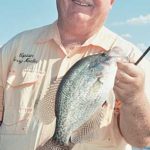
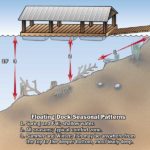
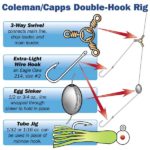
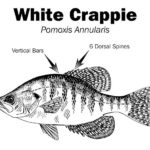
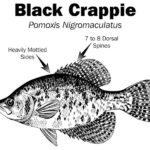
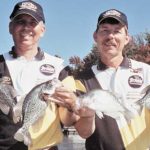
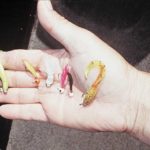


Be the first to comment